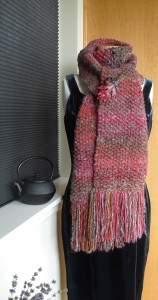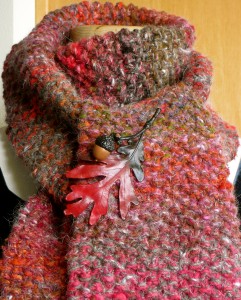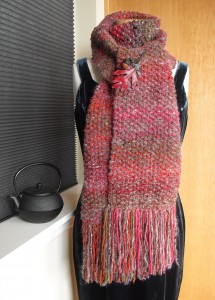I know, you have been wondering where I am and what I have been up to. I haven’t been idle! Here is some of the stuff I have been doing!
I have been working really hard on knitting and designing hats, mittens and gloves over the last three weeks. This is a new discipline for me. I have never made gloves or hats before January 1, 2012! And I made a New Year’s Resolution to do so this year! As I mentioned yesterday I am taking classes in these subjects. And, as it is my best personal mode of learning, I am just jumping in and doing some designs of my own at the same time. I feel ready to share a few of them now. So, starting tonight, I’ll unveil one to show you!
Voila! I created this hat which I am calling my ” Portrait Cloche in Honor of Edward Hopper.” It is hand knitted of hand dyed 100% alpaca which is incredibly soft and warm. Pure Luxury!
I designed and made it to attend an art museum opening of Edward Hopper’s paintings. I wanted to make a hat in the style of the ones the women in his paintings wore. I also wanted it to look like a proper 1920’s ~ 30’s formed felt hat, rather than a knitted hat so I made it very thick and sculptural with a turned back rim and graduated shaping. I made a very thick sculptural bow to cover the left side of the hat. It comes down over the left ear and has the added benefit of being like a very warm ear muff! You could place the bow over the right ear instead if you preferred to do so.
This hat is very thick and warm, but I may have to try making one with my trademark earmuff bow on both sides now! I’m thinking of ways to keep even warmer on my 4th day of being completely snowed in! And it is still snowing out! We are in the middle of a huge snowstorm in Seattle and I am taking advantage of using this time to post my designs and knitting projects and related stuff on the knitting website Ravelry! (Honestly, I would rather be knitting!)
I’m really happy with the way this hat turned out. I wasn’t exactly sure of what I was doing as I made it but it is perfect and exactly what I had in mind. I am considering writing the pattern so I can offer it to other knitters who would like to make one, but, to do that, I must make another one and carefully write down the steps as I go. I think I should do it in a lighter color so the details really show up. As usual I kept copious design and construction notes on this one, but nobody but me can understand them! I always work the initial design out that way, then redo it for a final run through and perfection test to be sure somebody else can understand and follow them. I probably should point out that this hat requires good technical sewing skills as well as knitting skills.
I wear this one with a vintage navy blue 1930’s coat in wool gaberdine and a purple wool dress. The outfit is totally inspired by the women in Hopper’s paintings who are always dressed in strong clear distinctive colors. I get a lot of inspiration for my clothing from painters. I like to recreate the moods, styles, and colors of the paintings in the way I dress.

Lady Violette's Portrait Cloche In Honor of Edward Hopper ~ Viewed From the Front ~ Features Deep Sculptural Horizontal Ribbing, a Turned Back Brim for Double Thick Forehead Warmth, & Her Trademark Thick Earmuff Bow
My “Portrait Cloche in Honor of Edward Hopper” also reminds me of Dorothy Parker, the brilliant writer, who also dressed really well. She was known for her feminine suits and adorable accent hats like this one. I just know she would have wanted to wear one of these! Do you English majors out there who are interested in fashion agree with me?
I can also wear this hat with a deep purple wool crossover wrap and tie coat with a big ruffled collar. This is more of a 1970’s look, but also very successful. It looks great with this hat. In fact, once I finished the hat I found quite a number of interesting things in my closet that I could use it with. So many I want to go out! I am feeling so horribly house bound! I haven’t been able to get out to go anywhere since last Saturday night. I’d love to get bundled and dressed up in my purple and blue winter ensemble and go to some elegant cafe wearing my “Portrait Cloche.” As soon as I can get out of here I will and I’ll get someone to take a proper photograph of me in the Portrait Cloche In Honor of Edward Hopper in the right atmosphere worn with the right era vintage clothes. This may still be a few days off as it is still snowing like mad! The airports are closed and the streets are blocked off! My classes have all been cancelled.
We only get snow like this in Seattle once every 2 or 3 years. It is inconvenient, but I also love it! I like the opportunity to stay home because I must and get some other things done. And I love the cold and the whiteness and the excitement in the air that the snow brings with it. A lot of people get very upset about their busy schedules getting interrupted, but I don’t. I see it as an opportunity to slow down and get a few things done that I normally do not have time for. Like making a couple of new hats! And setting up my Ravelry knitting site – which is a hugely time consuming project.
And, of course, get back to posting on my blog. So, back to the blog, as I promised and back to the “Portrait Cloche” : Let’s look at some pictures of it from all angles so you can really see what it looks like.

A Profile Shot From the Right Side of Lady Violette's Portrait Cloche In Honor of Edward Hopper. Here I have turned the hat and placed the bow on the right side and toward the back to show a different way to wear it!
I used Baby Alpaca Grande Hand Dye from Plymoith Yarn to make this hat because I happened to already have two balls of it in the perfect colorway of Blue/ Purple. I had hoped to get the hat and big bow out of one skein, but no such luck! It took about 1 and 3/4 altogether. Thus the yarn for this hat cost $40 plus sales tax! Expensive for a hat! But worth it to me. It is very stylish, warm and soft. Alpaca yarn is very luxurious and not at all scratchy. Even people with wool allergies can often wear it successfully. It is important to select non-scratchy or itchy yarn for a hat. I have made the mistake of using 100% wool that caused my forehead to itch and gave me a rash after a half hour. That quickly ruins the hat I spent hours making for me!
I plan to use the small amounts of left over alpaca yarn to decorate the violet tweed gloves I am currently making with little bows to co-ordinate with this hat. That should be really feminine and appropriate to the era that inspired me. And the gloves will be beautiful with the two ensembles I have described above. Here is a picture of them now as works in progress. I am finding it really interesting to construct them on the tiny tiny needles

Violet Tweed Five Finger Gloves With Bracelet Length Cuffs. This is the first pair of Five Finger Gloves I have ever made!
I am going to try to find another suitable yarn to make a spring/summer version of this hat – hopefully using one ball of a nice looking yarn and costing under $25 to make. I want to offer beautiful patterns that can be made up in affordable yarn. Anybody have any good suggestions? This one needs to be really bulky!
I keep trying to make hats out of one ball of yarn but I keep running out and needing to get a second one. This has happened on the Noro Spiral Beanie hat I am currently making as well. (See my work in progress in Noro Silk Garden in pastel colors and gray. I’ll post a picture of that here tomorrow.)
I am about to begin writing up several of my personal knitting pattern designs so other knitters can make them. I know cost of yarn and supplies is an issue for many people so I am planning to suggest several types of yarns in different price ranges so people have a choice. I am always making new things out of old ones and creating new things out of found fabrics and supplies – so this issue is always on my mind. I’d love to hear suggestions from readers of alternate materials you think would work as well. I’ll seriously consider them.
I will be writing out the design and instructions for making Lady Violette’s Portrait Cloche In Honor of Edward Hopper Soon. When it is done & available I will post it here and on Ravelry. Check back if you want the pattern. We could even do a supervised knit along to make it here on my blog if a few people are interested.
If you are interested in making this hat let me know. It is not hard to make. In addition to the ability to read a knitting pattern, you only need these basic knitting skills:
1) Cast On
2) Knitting,
3) Purling
4) Decreasing
5) Binding Off
6} Sewing a straight knitted seam together in mattress stitch
7) Picking up & Knitting stitches
8) Steam Blocking
About Ravelry. It is a knitting and crocheting social networking website, like Facebook for knitters and crocheters. In order to access it it is necessary to join it, even if you are not a knitter or crocheter or other needle worker. However, it doesn’t cost you anything to join. It is am amazing resource and I feel it is well worth joining even if you currently simply enjoy looking at what other crafters and fiber artists are doing.
It is also the last word on finding information and sharing your work. I am ladyviolette on Ravelry.
If you visit me on Ravelry you can view all my current projects in these areas and see pictures and read about my past work in those disciplines.
I’d love it if you come by and see me sometime. So will you, I guarantee it!
























